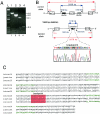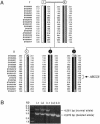A spectrum of ABCC6 mutations is responsible for pseudoxanthoma elasticum
- PMID: 11536079
- PMCID: PMC1226061
- DOI: 10.1086/323704
A spectrum of ABCC6 mutations is responsible for pseudoxanthoma elasticum
Erratum in
- Am J Hum Genet 2001 Dec;69(6):1413
- Am J Hum Genet 2002 Aug;71(2):448
Abstract
To better understand the pathogenetics of pseudoxanthoma elasticum (PXE), we performed a mutational analysis of ATP-binding cassette subfamily C member 6 (ABCC6) in 122 unrelated patients with PXE, the largest cohort of patients yet studied. Thirty-six mutations were characterized, and, among these, 28 were novel variants (for a total of 43 PXE mutations known to date). Twenty-one alleles were missense variants, six were small insertions or deletions, five were nonsense, two were alleles likely to result in aberrant mRNA splicing, and two were large deletions involving ABCC6. Although most mutations appeared to be unique variants, two disease-causing alleles occurred frequently in apparently unrelated individuals. R1141X was found in our patient cohort at a frequency of 18.8% and was preponderant in European patients. ABCC6del23-29 occurred at a frequency of 12.9% and was prevalent in patients from the United States. These results suggested that R1141X and ABCC6del23-29 might have been derived regionally from founder alleles. Putative disease-causing mutations were identified in approximately 64% of the 244 chromosomes studied, and 85.2% of the 122 patients were found to have at least one disease-causing allele. Our results suggest that a fraction of the undetected mutant alleles could be either genomic rearrangements or mutations occurring in noncoding regions of the ABCC6 gene. The distribution pattern of ABCC6 mutations revealed a cluster of disease-causing variants within exons encoding a large C-terminal cytoplasmic loop and in the C-terminal nucleotide-binding domain (NBD2). We discuss the potential structural and functional significance of this mutation pattern within the context of the complex relationship between the PXE phenotype and the function of ABCC6.
Figures



References
Electronic-Database Information
-
- Celera, http://www.celera.com/
-
- GenBank, http://www.ncbi.nlm.nih.gov/Genbank/index.html (for BAC clone CIT987SK-A-962B4 [accession number U91318], BAC clone CIT987SK-A-13F4 [accession number AC002039], BAC clone CIT987SK-A-589H1 [accession number AC002045], BAC clone CIT987SK-A-256A9 [accession number AC002492] ABCC6 cDNA [accession number NM_001171], chromosome 16 working-draft segment [accession number NT_010393], ABCC7 cDNA [accession number NM_000492], ABCC8 cDNA [accession number NM_000352], ABCC1 cDNA [accession number XM_017599], ABCB1 cDNA [accession number NM_000927], and NPIP cDNA [accession number XM_017612])
-
- Institut de Biologie et Chimie des Protéines, http://www.ibcp.fr (for ClustalW program)
-
- Institute for Genomic Research, The, http://www.tigr.org
References
-
- Aleksandrov L, Mengos A, Chang X-B, Aleksandrov A, Riordan JR (2001) Differential interactions of nucleotides at the two nucleotide binding domains of the cystic fibrosis transmembrane conductance regulator. J Biol Chem 276:12918–12923 - PubMed
-
- Allikmets R, Shroyer NF, Singh N, Seddon JM, Lewis RA, Bernstein PS, Peiffer A, Zabriskie NA, Li Y, Hutchinson A, Dean M, Lupski JR, Leppert M (1997a) Mutation of the Stargardt disease gene (ABCR) in age-related macular degeneration. Science 277:1805–1807 - PubMed
-
- Allikmets R, Singh N, Sun H, Shroyer NF, Hutchinson A, Chidambaram A, Gerrard B, Baird L, Stauffer D, Peiffer A, Rattner A, Smallwood P, Li Y, Anderson KL, Lewis RA, Nathans J, Leppert M, Dean M, Lupski JR (1997b) A photoreceptor cell-specific ATP-binding transporter gene (ABCR) is mutated in recessive Stargardt macular dystrophy. Nat Genet 15:236–246 - PubMed
-
- Bacchelli B, Quaglino D, Gheduzzi D, Taparelli F, Boraldi F, Trolli B, Le Saux O, Boyd CD, Ronchetti IP (1999) Identification of heterozygote carriers in families with a recessive form of pseudoxanthoma elasticum (PXE). Mod Pathol 12:1112–1123 - PubMed
Publication types
MeSH terms
Substances
Associated data
- Actions
- Actions
- Actions
- Actions
- Actions
- Actions
- Actions
- Actions
- Actions
- Actions
- Actions
- Actions
- Actions
Grants and funding
LinkOut - more resources
Full Text Sources
Other Literature Sources
Medical
Molecular Biology Databases

